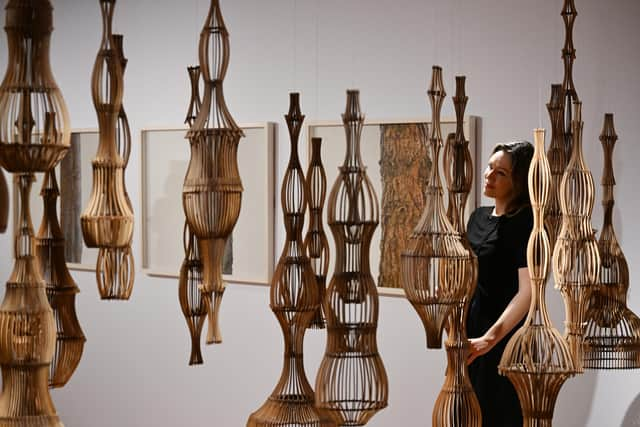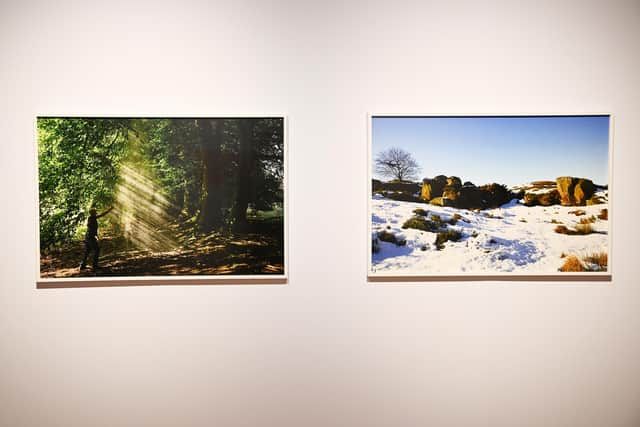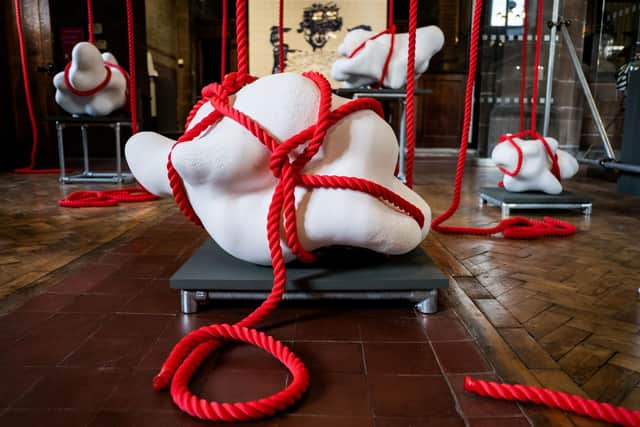Art reviews: Deep Rooted | FORM
Deep Rooted, City Art Centre, Edinburgh ****
FORM, Summerhall, Edinburgh ****
Contemporary art has a complicated relationship with landscape. Currently, two floors of Edinburgh’s City Art Centre are full to bursting with the entries for the Scottish Landscape Awards in every conceivable style and medium. Conspicuous by their absence (mostly) are those whose practices are concept-led.
Fortunately, curator Maeve Toal has brought together a show on the next floor up featuring artists such as Dalziel + Scullion, Andy Goldsworthy, Anya Gallaccio and Hanna Tuulikki, artists who have engaged long and deeply with these themes. Deep Rooted focusses primarily on trees, which embody some of the knotty contradictions in our relationship with nature: strong, monumental things which are nonetheless vulnerable both to environmental change and to deliberate destruction by human beings.
Advertisement
Hide AdDalziel + Scullion invite us to look more closely, to appreciate in near-forensic detail. Their photography series, Unknown Pines, invites us to gaze at the different types of pine bark, while the film Imprint applies a similar high-definition aesthetic to a whole wood.
Andy Goldsworthy’s practice has shifted, in the last dozen years, from making sculptures in landscape to making photographs which explore his own presence in landscape, often using his own body. He parks his likeness in a lone tree at a Yorkshire quarry, and throws a handful of dust in the air to make visible the sunlight falling through a canopy of branches.
Anya Gallaccio’s practice has shifted too, from using flowers and fruit in her work and building in a process of decay, to casting ephemeral objects in enduring ways. Her holly twigs cast in bronze, adorned with glass berries, are beautiful and elegiac, monumentalised but inert. Naomi Mcintosh captures ephemeral things, like the songs of threatened bird species, in sculptural constructions woven from wood.


Andrew Mackenzie is a landscape painter who makes meticulous paintings of forests overlaid with geometric or architectural forms. Though one might see, in these straight neon lines, the surveyor’s theodolite planning the next housing scheme or motorway, they aim to embody the tension of the natural and man-made as coexistence rather than opposition. Katie Paterson takes the long view, with her incense sticks which capture the scent of the “first” and “last” forests.
One of the most powerful works in the show is Hanna Tuulikki’s immersive Under Forest Cover/Mesänpeitan Alla, made for the Helsinki Biennale in 2021. Inhabiting a birch forest with her own flickering, glitching image and haunting song, she seems to capture simultaneously an ancient fear and a modern one: that of being lost in a forest, and that of the forest itself, and its magic, becoming lost to us.
The environmental concerns of Deep Rooted are present explicitly in Sounding Line, by artist and activist Mella Shaw, in Summerhall Arts’s FORM, a group of five exhibitions by five female artists made possible by Summerhall’s new independently run charity which aims to support visual artists at different stages of their careers.
Advertisement
Hide AdSounding Line, which was the winner of the top prize at the British Ceramics Biennial in 2023, was made in response to a mass beaching of dead whales in Scotland and Ireland five years ago, in which noise pollution in the oceans – particularly the increased use of sonar – is believed to have played a major role.


Taking bone from a Northern bottlenose whale beached on South Uist and grinding it down to make bone china, Shaw used the ceramic to make giant sculptural forms based on the intricate bones in a whale’s eardrum. Each is tightly bound in bright red nautical rope which pulses with sonar-like vibrations.
Advertisement
Hide AdThe idea of taking a tiny bone from an immense creature and replicating it in monumental size strikes the same note of vulnerability that Deep Rooted hints at. It’s a dynamic, visually powerful work which embodies the story it wants to tell. Without simplifying it, it simply makes it real.
Yumiko Ono works on a large scale too. Her Composition IV is an impressive four-way arch which barely seems to fit into the upstairs Corner Gallery. First developed at Edinburgh Sculpture Workshop, the work is a series of sculptural building blocks which she configures in different ways.
There is a quiet, temple-like precision about this construction of cubes and white tiles of latticed ceramic. Its exploration of atmosphere, proportion and space is verging on the architectural. It’s ambitious and mature work which might need a bigger gallery to be fully appreciated. On the other hand, perhaps that’s the point.


Artist Emma Hislop has made work for a new space not previously open to the public, the Post Mortem Room of the former Vet School. Responding to the space with an installation called What is Left Behind, she works by juxtaposing images and ideas, musing on the Apprentice Pillar at Rosslyn Chapel and the nearby new home of the Vet School at Roslin.
A sculptural pillar made of bronze and laser-cut metal takes centre stage, with a large photograph of the Rosslyn pillar swathed in a sheet hanging behind it. Drawings etched on glass add further images: a Green Man, the statue of a horse. What she wants us to take away from these juxtapositions is less clear, and the work seems to contend with the powerful atmosphere of the space itself.
Camila Ospina Gaitán, originally from Colombia, who graduated from the MFA programme at Edinburgh College of Art in 2021, makes work which is concerned with the male gaze. The four rooms she presents here under the title, An Uncanny Feeling That She Was Being Watched, almost feel like four distinct shows, each approaching her subject in a different way.
Advertisement
Hide AdSome of the most interesting work is in glass: intricate shapes in flamework glass made into delicate necklaces or draped over black sculptural cones; blown glass shapes evoking female bodies. She clearly has plenty to say, but it feels like her practice needs to further evolve so that the various forms speak to her ideas with greater clarity.
Another young artist, Rowan Walker, who graduated from ECA in 2023, presents her first show in the Basement Galleries. Foreign Objects is an exploration of hospitals and medical procedures, past and present, and these white, artificially lit rooms are the ideal place for it. The addition of a hospital curtain in one corner is the finishing touch.
Advertisement
Hide AdThis extensive body of work comes at her subject from a variety of angles. There are 18th- and 19th-century medical tools encased in gel and plastic and suspended from the ceiling, a piece of lace made from silicon the colour of skin, hospital wrist bands remade in leather, a model of a lie detector machine, no less sinister for being stripped of its function. One of the strongest pieces is Limits II, a stainless steel strip made to look like a spine, curving impossibly, painfully, beyond its natural limits.
There’s a lot of strong work here, which would be even stronger if the individual pieces felt as if they were working together to a greater extent. Of the shows in FORM, some are more fully realised than others. The great thing is that funded programmes such as this one continue to emerge to give artists space to get on with doing the realising.
Both exhibitions run until 25 February